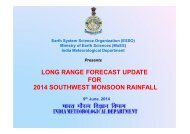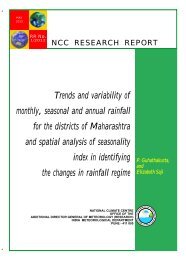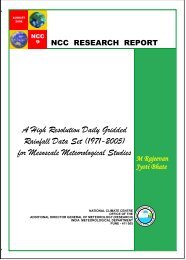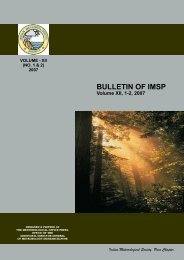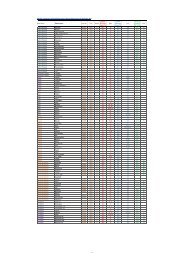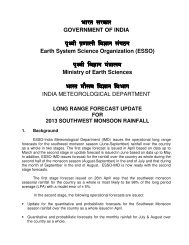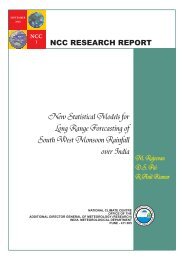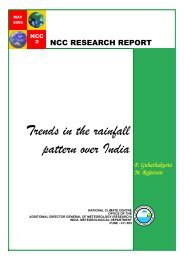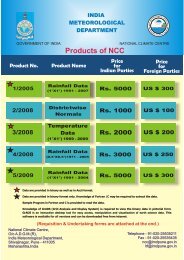5 India Meteorological Department Central Training ... - (IMD), Pune
5 India Meteorological Department Central Training ... - (IMD), Pune
5 India Meteorological Department Central Training ... - (IMD), Pune
You also want an ePaper? Increase the reach of your titles
YUMPU automatically turns print PDFs into web optimized ePapers that Google loves.
of NWP products. Stream function, velocity potential and vertical velocity. Numericalexperiments with NWP models (WRF & AGCM).Paper-3 Physical Meteorology & Physical Oceanography(Total Hours = 90)Section- A: Physical MeteorologyTheory (Total Hours = 40)• Thermal structure of the atmosphere; troposphere, stratosphere, mesosphere,thermosphere, and explanation of these. Basic ideas and concepts of QBO, andstratospheric warming. Tropopause breaks. ( 7 hours).• Theory of atmospheric visibility by day and night, atmospheric optics (basic ideas).Effect of air pollution on visibility. <strong>Meteorological</strong> Optical Range (MOR); concept andapplication.( 5 hours).• Cloud Physics – initial stage of condensation; curvature effect; condensation nuclei;growth of cloud droplets by diffusion and by coalescence; collection efficiency; freezingnuclei; formation of ice and snow; Precipitation, rain making experiments, weathermodification. Theories of generation of hail in thunderstorms. (8 hours).• Fair weather electrical field of the atmosphere, electrical conductivity and ionizationin the atmosphere, thunderstorm electrification, lightning discharge. (7 hours).• Air pollution: Basic ideas and concept of air pollution; sources, causes, Impact of airpollution on health, acid rain meteorological factors affecting air pollution, wind rosediagram.(7 hours).• Ozone; Ozone hole, CFC and awareness of Montreal protocol.Radar Meteorology :-Doppler Radar; basic principal and application.( 6 hours).Practical (Total Hour = 20)• Study of stability conditions for given sounding data.( 6 hours).• Determining the perceptible water vapour amount.(4 hours).• Computation of various stability Indices for prediction of thunderstorms (10 hours)Section – B: Physical Oceanography(Total hours =30)• Geographical data relating to oceans and their importance ( 2 hours).• Physical properties of sea water; T – S diagram (3 hours)• Absorption of solar radiation (2 hours)• Extinction coefficient in the sea (2 hours)5



